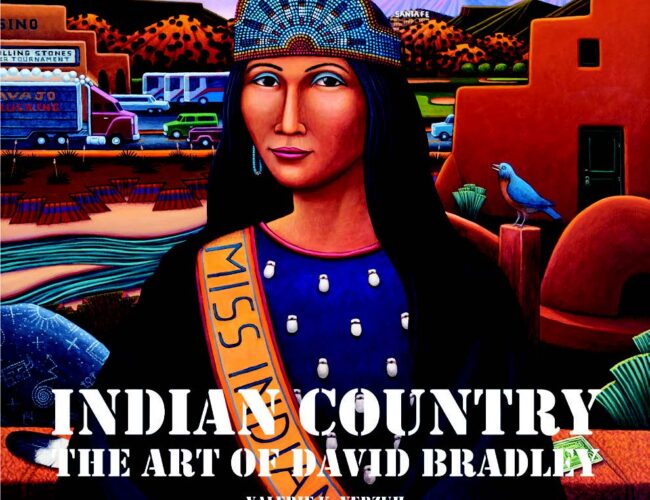Indian Country
The Art of David Bradley
 Jacketed hardcover, $34.95, 144 pages, 75 color plates. This and other publications by the Museum of New Mexico Press are available at bookstores and museum shops, including the Museum of New Mexico Foundation Shops in Santa Fe, or by calling 800-249-7737, or at mnmpress.org.
Jacketed hardcover, $34.95, 144 pages, 75 color plates. This and other publications by the Museum of New Mexico Press are available at bookstores and museum shops, including the Museum of New Mexico Foundation Shops in Santa Fe, or by calling 800-249-7737, or at mnmpress.org.
BY VALERIE K. VERZUH
Through his career, artist David Paul Bradley, an enrolled member of the Minnesota Chippewa Tribe, has become a recognized voice from Indian Country.
For more than thirty years, he has reappropriated and redefined images from both inside and outside Native American communities in exploring issues of self-image, self-determination, and self-portrait. His approach to the self-portrait reveals many aspects of his life: family, community, connections to specific places and people, his sense of humor and outrage, strongly held beliefs and politics. …
David Bradley’s artworks are narratives from inside Indian Country. Through his paintings, mixed-media works, prints, and sculptures, he tells stories and histories not often heard by non-Native people nor understood from a Native American perspective. Bradley’s artworks redirect the gaze of American life by depicting daily lives, actions, thoughts, and histories from an Indian point of view. Saturated with a powerful Native voice and evocative visual descriptions of Indian experience, Bradley’s paintings interweave historical and political truths, social and personal narrative, and cultural critique.
In Bradley’s narratives of the American West, the Pueblo feast table is a metaphor for Indian Country. … As Bradley has said, “[Feast day] is one of the few times during the year that these communities welcome the whole world into the pueblos for openness and sharing.” At Bradley’s feast day tables, American culture is turned inside out and dominant relationships are reversed. Tonto and the Lone Ranger, and other icons of American culture, become guests at the table, guests in Indian Country.
Through their eyes, Native Americans have always been essential participants in the shaping of American society, yet, understanding the American Indian experience has always challenged mainstream America. There are many Native American cultures and a multitude of diverse life experiences. Some Native Americans have been raised on reservations, others in urban settings, and still others travel between both. A majority of Native Americans today are bicultural or multicultural. In Bradley’s art, diverse American (and world) cultures meet, interact, and step across cultural boundaries. Art is a powerful force in the development of cultures; it also can be a unifying bridge between cultures.
In Bradley’s narratives of Indian Country, Native people take center stage in world art and history. Through his artwork he challenges imbedded assumptions about people, places, and events we only think we comprehend, revealing the indigenous experiences forever at the core of what it means to be American. Some paintings reconsider the past; others explore how Indigenous peoples formulated new identities yet preserved their culture. Bradley also focuses on Indian Country from the vantage point of both historic and contemporary interactions between Indian people and outsiders. Looking critically at his depictions of Indian Country, viewers learn that Native and non-Native American interactions have always taken place on two levels—the real and the imaginary.
Excerpted from the Museum of New Mexico Press book. Jacketed hardcover, $34.95, 144 pages, 75 color plates. This and other publications by the Museum of New Mexico Press are available at bookstores and museum shops, including the Museum of New Mexico Foundation Shops in Santa Fe, or by calling 800-249-7737, or at mnmpress.org.
